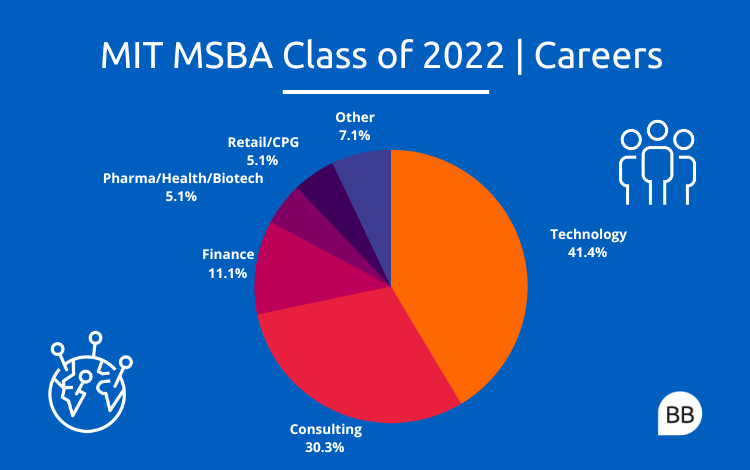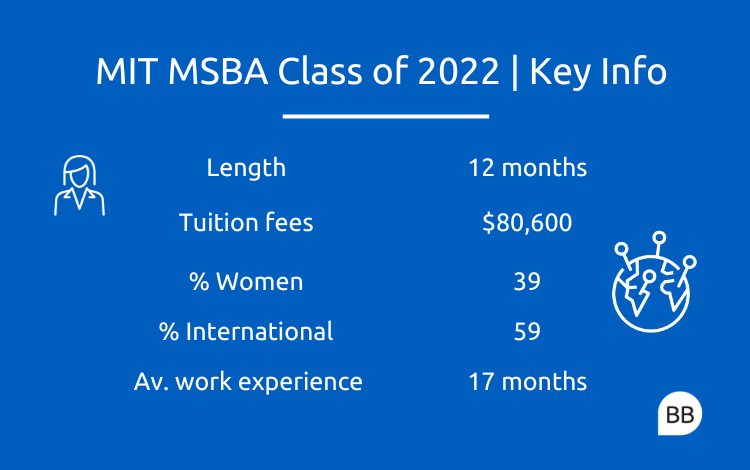Business analytics skills are in high demand across all business sectors, with an increasing number of specialized Masters in Business Analytics focused on both management and data analysis.
The MIT Master of Business Analytics (MBAn), offered by MIT Sloan School of Management, is one such program. The MBAn is a STEM-designated program focused on the application of the tools of modern data science, optimization, and machine learning to solve real-world business problems.
Here, we break down everything you need to know about the MIT MBAn, from what you can expect from your class and curriculum to your post-degree jobs prospects.
MIT Master of Business Analytics | Key Info
MIT MBAn | Overview & Class Profile
The MIT MBAn is a 12-month program aimed at giving students the skills and knowledge necessary to apply data science to the business world.
Sitting at the crossroads of business and science, the MBAn taps into MIT’s global reputation for science and technology. The MBAn was established in conjunction with MIT’s Operation Research Center, a leading interdisciplinary research institute.
In a class of 66, students largely come from science, technology, engineering, and mathematics (STEM) backgrounds. In the class of 2022, 87% of students had STEM backgrounds.
The majority (35%) had math and science bachelor’s degrees. A further 24% came from engineering backgrounds, 18% were economics undergrads while 12% studied computer science before enrolling.
Students had on average 17 months of work experience before entering the program.
The class is 39% female, and 59% international, with 24 countries represented.
MIT MBAn | Curriculum
As with most business masters degrees, the MBAn is divided into core courses and electives.
All students must sit eight core courses, which include machine learning, optimization methods, analytics edge, analytics software tools (such as R, Python, SQL, and Julia), and communicating with data.
Electives allow students to take a deeper dive into subjects of their choice. Students must choose between three and six electives, with courses including advanced topics in artificial intelligence, statistical learning theory, entrepreneurship lab, analytics of finance, crypto finance, and machine learning in healthcare.
Alongside classroom-based learning, students take part in an Analytics Capstone Project. Here, student teams work on data science problems with real companies over the course of seven months, with the support of faculty mentors.
Companies involved in the Capstone Project in the past have included consumer goods companies like Annheuser-Busch and Unilever, automobile giants like BMW and General Motors, and pharmaceutical companies like Pfizer. The project is capped off with a full-time summer internship at their allocated company at the end of the program.
The Capstone Project has more than just academic benefit. Companies offset $22,000 from each student’s tuition.
READ: 10 Best Masters In Business Analytics
© MIT Sloan via Facebook
MIT MBAn Application & Cost
Total tuition costs and fees for the MBAn add up to $86,000. Subtracting the $22k contribution from Capstone companies, students pay $60,368. In addition, MIT Sloan estimates total personal and living expenses to add up to $50,965, bringing the total cost to around $137,265.
On top of ordinary student loans, MIT also has a number of ways to support students with tuition. Several fellowships are awarded to students with outstanding academic backgrounds, personal achievements, and professional promise.
MBAn students can also take part in assistantships, supporting faculty in research projects and academic activity. As well as helping students cover expenses, this offers great exposure to MIT’s research programs.
To apply for the MBAn, candidates must submit a one-page resume, three letters of recommendation (two from academic sources and one from an employer), academic transcripts, GMAT or GRE test scores, plus a $150 application fee.
Candidates must submit a 500-word essay answering the question:
'Please tell us why you’re pursuing the Master of Business Analytics degree at MIT Sloan. What do you hope to gain from the program? What are your career aspirations?'
Candidate also need to submit two one-minute videos on the following:
Video Question 1: Introduce yourself to your future classmates, here's your chance to put a face with a name, let your personality shine through, be conversational, be yourself. We can't wait to meet you!
Video Question 2: A brief video statement in response to a simple, open-ended general interest question. The question is designed to help us get to know you better; to see how you express yourself and to assess fit with the MIT Sloan culture.
Shortlisted candidates will be invited to interview, which assesses you both technically and behaviourally. Prior to the interview, candidates have to submit a recent data science or analytics paper they have worked on, with three presentation slides to represent the work.
MIT MBAn | Career opportunities

In the class of 2021, 100% of job-seeking graduates accepted a job offer within six months, with an average base salary of $127,750.
Technology was the most popular industry, with tech companies hiring 41% of graduates, followed by consulting (30%) and finance (11%). Pharmaceuticals & healthcare, and retail and consumer goods each hired a further 5% of the class.
Top employers include big tech firms like Amazon, Meta, and TikTok (Bytedance), consulting firms McKinsey & Co. and Boston Consulting Group, and pharmaceutical giants including Sanofi and Pfizer.
For those looking to stay and work in the US, the MBAn has particular advantages. The MBAn is a STEM-designated program, meaning international graduates are granted a two-year extension to their one-year optional practical training (OPT) allowing them to stay in the US to work without an H-1B work visa.
98% of MIT MBAn students seeking roles landed roles based in the US.

Given MIT’s reputation for science and technology, as well as Sloan’s status as a high-ranking business school, employers are sure to favor MIT MBAn graduates.
While the program is costly for a one-year master’s, the tuition contribution by Capstone companies, as well as the work experience the project provides, ensures both a significant subsidy and strong return on investment.
The MBAn’s STEM-designation is also a huge asset for international students looking for work in the US. Companies are often put off hiring students who can only stay one year after graduation, so a three year OPT extension is a bonus.

Next Read:
Masters In Business Analytics Salary: What Can You Expect To Earn?





